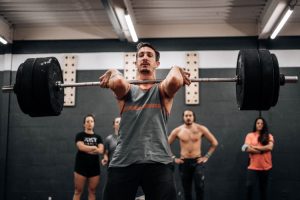Front squats have always held a reputation as one of the most challenging exercises in the realm of strength training. Many seasoned athletes, powerlifters, and bodybuilders consider them significantly more demanding than their counterpart, the back squat. But why is it that the front squat is so much harder? In this article, we will delve deep into the mechanics, benefits, and challenges of front squats to unravel the mystery behind their difficulty.
Introduction
Front squats, a staple in strength training, have gained recognition for their capacity to challenge even the most experienced athletes. In this article, we will explore the key factors contributing to the difficulty of front squats, along with their numerous benefits.
Front Squat vs. Back Squat
Before delving into the intricacies of front squats, it’s essential to distinguish them from the more conventional back squats. While back squats involve the barbell placed on the upper back, front squats require the bar to rest on the front shoulders. This key difference changes the entire dynamic of the exercise.
The Mechanics Behind the Front Squat
Front squats emphasize an upright posture with the torso more inclined, shifting the focus to the quadriceps, core, and upper back. The mechanics behind this exercise play a crucial role in making it more challenging.
Engaging the Core
Front squats engage the core muscles to a greater extent than back squats. The need to maintain an upright posture places significant demands on the abdominal muscles, making it harder to stabilize the spine.
Wrist and Shoulder Mobility
The grip for front squats can be uncomfortable for those with limited wrist and shoulder mobility. Achieving a proper rack position requires flexibility and adaptability.
Bar Placement
The placement of the bar in front squats demands excellent front shoulder strength and stability. This increases the overall difficulty level of the exercise.
Benefits of Front Squats
Front squats offer several advantages that make them worth the challenge.
Strengthening the Upper Back
The need to maintain an upright posture during front squats significantly strengthens the upper back muscles, improving overall posture.
Enhancing Posture
Front squats promote a more natural, upright posture and prevent excessive forward lean, which is common in back squats.
Increased Quadriceps Activation
Front squats emphasize the quadriceps, leading to more substantial activation and growth in this muscle group.
Challenges of Front Squats
Let’s explore the various challenges that make front squats significantly harder for most individuals.
Learning Curve
Front squats require a learning curve due to their unique bar placement and balance. It takes time to adapt and execute them correctly.
Greater Demand on the Core
The need for core engagement places additional stress on the abdominal muscles, making the exercise more demanding.
Mobility Limitations
Individuals with limited wrist, shoulder, or hip mobility may struggle to perform front squats with proper form.
Front squats are indeed more challenging than their counterpart, the back squat. However, their unique mechanics and the demands they place on the core, upper back, and mobility offer various benefits that make them a valuable addition to any strength training regimen.
Frequently Asked Questions (FAQs)
- Are front squats suitable for beginners?
Front squats can be challenging for beginners due to their unique mechanics, but with proper guidance and form, they can be integrated into a training program. - How can I improve my wrist and shoulder mobility for front squats?
Regular stretching and mobility exercises can help improve wrist and shoulder flexibility, making it easier to perform front squats. - Do front squats work the same muscles as back squats?
Front squats place more emphasis on the quadriceps, core, and upper back, while back squats engage the posterior chain and glutes to a greater extent. - What is the ideal set and rep scheme for front squats?
The ideal set and rep scheme can vary depending on individual goals, but a common starting point is 3-4 sets of 6-8 repetitions. - Can front squats help improve posture?
Yes, front squats promote an upright posture and can help improve posture over time by strengthening the upper back and core muscles.
In conclusion, front squats may be more challenging, but the benefits they offer are well worth the effort. With practice, patience, and a focus on mobility and core strength, anyone can master the art of front squatting and reap the rewards it has to offer.
Remember to, Flex at Ur Prime.





